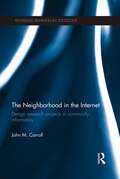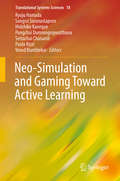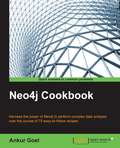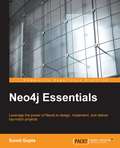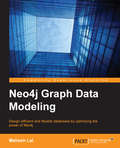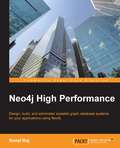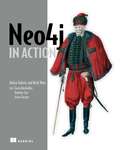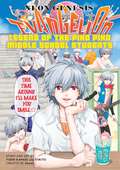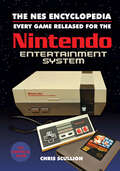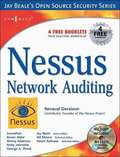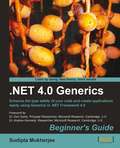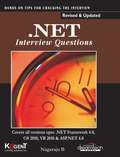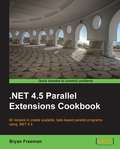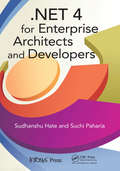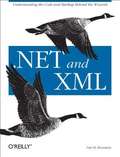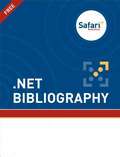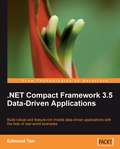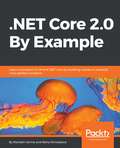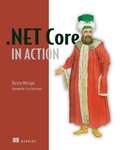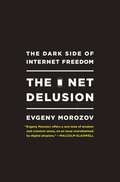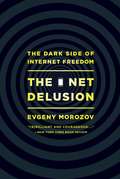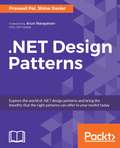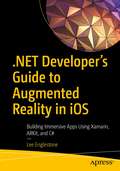- Table View
- List View
The Neighborhood in the Internet: Design Research Projects in Community Informatics (Routledge Advances in Sociology)
by John M. CarrollToday, "community" seems to be everywhere. At home, at work, and online, the vague but comforting idea of the community pervades every area of life. But have we lost the ability truly to understand what it means? The Neighborhood in the Internet investigates social and civic effects of community networks on local community, and how community network designs are appropriated and extended by community members. Carroll uses his conceptual model of "community" to re-examine the Blacksburg Electronic Village – the first Web-based community network – applying it to attempts to sustain and enrich contemporary communities through information technology. The book provides an analysis of the role of community in contemporary paradigms for work and other activity mediated by the Internet. It brings to the fore a series of design experiments investigating new approaches to community networking and addresses the future trajectory and importance of community networks. This book will be of interest to students of sociology, community psychology, human-computer interaction, information science, and computer-supported collaborative work.
Neo-Simulation and Gaming Toward Active Learning (Translational Systems Sciences #18)
by Hidehiko Kanegae Paola Rizzi Ryoju Hamada Songsri Soranastaporn Pongchai Dumrongrojwatthana Settachai Chaisanit Vinod DumblekarThis book provides tips to teachers for moving toward active learning by using simulation and gaming. The book is a rare reference for teachers who wish to initiate active learning by applying many real experiences from world experts in simulation and gaming. This cumulative wisdom comes from cutting-edge trials reported at the 49th International Simulation and Gaming Association’s annual conference in Thailand 9–13 July 2018. The importance of changing teachers’ one-way lecture approach to that of active learning has been commonly understood for several decades and has been promoted especially in recent years in Asian universities. Simulation and gaming meets the requirements of such teaching programs, especially for active learning, but there are few books or references on how to gamify a lecture. This book serves as a guide to facilitate that change. The author recognizes the duty to provide readers with fixed directions toward simulation and gaming in the next generation, which have still not been fully elucidated. Developing a simulation and gaming culture and making it sustainable in the next decade are the purpose of this book.
Neo4j Cookbook
by Ankur GoelIf you are already using Neo4j in your application and want to learn more about data analysis or database graphs, this is the book for you. This book also caters for your needs if you are looking to migrate your existing application to Neo4j in the future. We assume that you are already familiar with any general purpose programming language and have some familiarity with Neo4j.
Neo4j Essentials
by Sumit GuptaIf you are an application developer or software architect who wants to dive into the Cypher language and learn the concepts of graph theory and graph-based data models, this is the book for you. Prior experience with a graph-based or NoSQL-based database is expected. Some knowledge of Java will be beneficial, as this will give you more insights into Neo4j's extensibility.
Neo4j Graph Data Modeling
by Mahesh LalIf you are a developer who wants to understand the fundamentals of modeling data in Neo4j and how it can be used to model full-fledged applications, then this book is for you. Some understanding of domain modeling may be advantageous but is not essential.
Neo4j High Performance
by Sonal RajIf you are a professional or enthusiast who has a basic understanding of graphs or has basic knowledge of Neo4j operations, this is the book for you. Although it is targeted at an advanced user base, this book can be used by beginners as it touches upon the basics. So, if you are passionate about taming complex data with the help of graphs and building high performance applications, you will be able to get valuable insights from this book.
Neo4j in Action
by Tareq Abedrabbo Nicki Watt Dominic Fox Aleksa VukoticSummaryNeo4j in Action is a comprehensive guide to Neo4j, aimed at application developers and software architects. Using hands-on examples, you'll learn to model graph domains naturally with Neo4j graph structures. The book explores the full power of native Java APIs for graph data manipulation and querying.Purchase of the print book includes a free eBook in PDF, Kindle, and ePub formats from Manning Publications. About the TechnologyMuch of the data today is highly connected—from social networks to supply chains to software dependency management—and more connections are continually being uncovered. Neo4j is an ideal graph database tool for highly connected data. It is mature, production-ready, and unique in enabling developers to simply and efficiently model and query connected data. About the BookNeo4j in Action is a comprehensive guide to designing, implementing, and querying graph data using Neo4j. Using hands-on examples, you'll learn to model graph domains naturally with Neo4j graph structures. The book explores the full power of native Java APIs for graph data manipulation and querying. It also covers Cypher, Neo4j's graph query language. Along the way, you'll learn how to integrate Neo4j into your domain-driven app using Spring Data Neo4j, as well as how to use Neo4j in standalone server or embedded modes. Knowledge of Java basics is required. No prior experience with graph data or Neo4j is assumed. What's InsideGraph database patternsHow to model data in social networksHow to use Neo4j in your Java applicationsHow to configure and set up Neo4jAbout the AuthorsAleksa Vukotic is an architect specializing in graph data models. Nicki Watt, Dominic Fox, Tareq Abedrabbo, and Jonas Partner work at OpenCredo, a Neo Technology partner, and have been involved in many projects using Neo4j.Table of ContentsPART 1 INTRODUCTION TO NEO4JA case for a Neo4j databaseData modeling in Neo4jStarting development with Neo4j The power of traversalsIndexing the dataPART 2 APPLICATION DEVELOPMENT WITH NEO4JCypher: Neo4j query languageTransactionsTraversals in depthSpring Data Neo4jPART 3 NEO4J IN PRODUCTIONNeo4j: embedded versus server mode
Neon Genesis Evangelion: The Legend of Piko Piko Middle School Students Volume 2
by Yushi KawataShinji! Rei! Asuka! And of course...Kaworu! The elite four students of the National Defense Middle School...otherwise known as NERV! They're training to prevent the "New Century Apocalypse"...but will all their training help them when they're demoing dating sims on the main stage at Tokyo's largest game show? • Full of video game parodies--it's Evangelion meets Let's Play! • The most famous anime franchise of the last 20 years! • The latest anime movie, Neon Genesis Evangelion: 3.33 You Can (Not) Redo is available from Funimation. • Each volume contains four opening pages in full color.
The NES Encyclopedia: Every Game Released for the Nintendo Entertainment System
by Chris ScullionA comprehensive, colorful guide to every game ever released on the classic Nintendo Entertainment System. One of the most iconic video game systems, the NES is credited with saving the American video games industry in the early 1980s. The NES Encyclopedia is the first ever complete reference guide to every game released on the Nintendo Entertainment System, Nintendo&’s first industry-defining video game system. As well as covering all 714 officially licensed NES games, the book also includes more than 160 unlicensed games released during its lifespan, giving for the first time a definitive history of this important console's full library. Written by a retro gaming expert with 30 years of gaming experience and a penchant for bad jokes, TheNES Encyclopedia promises to be both informative and entertaining. The NES continues to enjoy a strong cult following among Nintendo fans and gamers in general with wide varieties of officially licensed merchandise proving ever popular. Nintendo&’s most recent console, the Switch, is the fastest selling video game console of all time in the United States and Japan. Nintendo launched a variety of classic NES games for download on the system, meaning a new audience of gamers is due to discover the NES for the first time if they have not already. Praise for The NES Encyclopedia &“As a catalog of all 876 NES games, this work is unique in its breadth of coverage and will be of great interest to old-school video gamers and collectors.&” —Booklist &“A definitive resource that is more than worthy of the title &‘Encyclopedia.&’ &” —Nintendo World Report
Nessus Network Auditing
by Jay Beale Renaud Deraison Haroon Meer Roelof Temmingh Charl Van Der WaltThis book focuses on installing, configuring and optimizing Nessus, which is a remote security scanner for Linux, BSD, Solaris, and other Unices. It is plug-in-based, has a GTK interface, and performs over 1200 remote security checks. It allows for reports to be generated in HTML, XML, LaTeX, and ASCII text, and suggests solutions for security problems. As with many open source programs, Nessus is incredibly popular, incredibly powerful, and incredibly under-documented. There are many Web sites (including nessus.org) where thousands of users congregate to share tips, tricks, and hints, yet no single, comprehensive resource exists. This book, written by Nessus lead developers, will document all facets of deploying Nessus on a production network.
.NET 4.0 Generics Beginner’s Guide
by Sudipta MukherjeeThis is a concise, practical guide that will help you learn Generics in .NET, with lots of real world and fun-to-build examples and clear explanations. It is packed with screenshots to aid your understanding of the process. This book is aimed at beginners in Generics. It assumes some working knowledge of C# , but it isn't mandatory. The following would get the most use out of the book: Newbie C# developers struggling with Generics. Experienced C++ and Java Programmers who are migrating to C# and looking for an alternative to other generic frameworks like STL and JCF would find this book handy. Managers who want to know what Generics is and how to put it to good use. Architects will find the benchmarking extremely useful, because it's the first of its kind across a framework of several collections.
.NET 4.0 Interview Questions
by Nagaraju B.Highly recommended for beginners, students, and professionals, this book covers the unknown or hidden areas of NET implementation, starting from the basic to the advanced level-from NET Framework to OOPS to remoting to web services, i.e. VBNET, C#NET, and ASP NET; from ADO NET to XML, XSL, and XSLT; from Remoting, which forms the basis for advanced BizTalk, to SharePoint; from smart devices to Web Services and NET Framework 3.0 that discusses WPF, WF, WCF, and WCS foundations, and much more. Contents:- Framework ? Programming Concepts ? OOPS ? Windows Forms Controls ? ADO NET ? eXtensible Markup Language (XML) ? Remoting ? ASP NET NET Compact Framework ? Web Services NET Framework 3.0
.NET 4.5 Parallel Extensions Cookbook
by Bryan FreemanThis book contains practical recipes on everything you will need to create task-based parallel programs using C#, .NET 4.5, and Visual Studio. The book is packed with illustrated code examples to create scalable programs.This book is intended to help experienced C# developers write applications that leverage the power of modern multicore processors. It provides the necessary knowledge for an experienced C# developer to work with .NET parallelism APIs. Previous experience of writing multithreaded applications is not necessary.
.NET 4 for Enterprise Architects and Developers
by Sudhanshu Hate Suchi PahariaPresenting cutting-edge insights from industry practitioners, .NET 4 for Enterprise Architects and Developers supplies in-depth coverage of the various server-side features of Microsoft .NET Framework 4 that can be leveraged in Enterprise Application development. It provides a fundamental understanding of the technical aspects of implementation and
.NET and XML
by Niel M. Bornstein.NET and XML provides an in-depth, concentrated tutorial for intermediate to advanced-level developers. Additionally, it includes a complete reference to the XML-related namespaces within the .NET Framework. XML is an extremely flexible technology, and Microsoft has implemented most of the tools programmers need to use it very extensively. .NET and XML aims to help you understand the intersection between the two technologies for maximum effectiveness.
.NET and XML
by Niel M. BornsteinIf you're seeking ways to build network-based applications or XML-based web services, Microsoft provides most of the tools you'll need. XML is integrated into the .NET Framework and Visual Studio .NET, but if you want to get a grasp on how .NET and XML actually work together, that's a different story. With .NET and XML , you can get under the hood to see how the .NET Framework implements XML, giving you the skills to write understandable XML-based code that interoperates with code written with other tools, and even other languages. .NET and XML starts by introducing XML and the .NET Framework, and then teaches you how to read and write XML before moving on to complex methods for manipulating, navigating, transforming, and constraining it. To demonstrate the power of XML in .NET, author Niel Bornstein builds a simple hardware store inventory system throughout the book. As you move from chapter to chapter, you'll absorb increasingly complex information until you have enough knowledge to successfully program your own XML-based applications. This tutorial also contains a quick reference to the API, plus appendices present additional .NET assemblies that you can use to work with XML, and how to work with the .NET XML configuration file format. One study puts the potential market for new software based on XML at or near $100 billion over the next five years. The .NET Framework gives you a way to become a part of it. But to use XML and .NET effectively, you need to understand how these two technologies work together. This book gives you the insight to take full advantage of the power the two provide.
.NET Bibliography
by Safari Content TeamWhen Microsoft released the first beta of the .NET Framework in 2000 it quickly became the default way of developing software for Windows. Rising from the technological legacy of COM, with the C# language, Common Language Runtime (CLR), Intermediate Language (IL) and Just-in-time (JIT) compilation, it was a modern platform that made it easy for Java and C++ developers to develop for Windows. At the same time, Visual Basic .NET provided a natural transition path for Visual Basic developers. Since then, .NET has evolved and branched through 7 major releases of the framework to the current day, and with Windows 8, Microsoft has surprised developers with a completely new UI stack. In this highly competitive world of technology, Microsoft makes the operating system that is running on over a billion computers, yet they continue innovating with unique features of programming languages, and breakthroughs such as Kinect or PixelSense. .NET offers an environment that is a pleasure to develop on and a consistent platform where you will feel at home moving from one technology stack to another. Should you decide to explore the exciting world of .NET development, be sure to use this bibliography to access Safari Books Online resources that will help you understand and master .NET programming.
.NET Compact Framework 3.5 Data Driven Applications
by Edmund TanThe book walks you through three different real-world mobile applications from head to toe to provide a practical, hands-on experience on how to use .NET CF. It provides you with code snippets (in both VB.NET and C#) from real-world business scenarios. A summary at the end of each chapter explains how these code snippets work together as a part of the larger whole. It also makes use of diagrams to explain core concepts and helps you decide on which design patterns to use in different enterprise application scenarios. This book is written for developers who are acquainted with the basics of .NET Compact Framework and want to create enterprise-level mobile applications. It is for developers who have worked with the .NET CF Framework before but would like to learn how to utilize its advanced features and deploy leaner and faster business applications.
.NET Core 2.0 By Example: Learn to program in C# and .NET Core by building a series of practical, cross-platform projects
by Neha Shrivastava Rishabh VermaBuild cross-platform solutions with .NET Core 2.0 through real-life scenariosKey Features Bridges the gap between learning and doing and improves your software development skills Covers the best practices of .NET development to improve your productivity Example-based approach to get you started quickly with software programmingBook DescriptionWith the rise in the number of tools and technologies available today, developers and architects are always exploring ways to create better and smarter solutions. Before, the differences between target platforms was a major roadblock, but that's not the case now. .NET Core 2.0 By Example will take you on an exciting journey to building better software.This book provides fresh and relevant content to .NET Core 2.0 in a succinct format that’s enjoyable to read. It also delivers concepts, along with the implications, design decisions, and potential pitfalls you might face when targeting Linux and Windows systems, in a logical and simple way.With the .NET framework at its center, the book comprises of five varied projects: a multiplayer Tic-tac-toe game; a real-time chat application, Let'sChat; a chatbot; a microservice-based buying-selling application; and a movie booking application. You will start each chapter with a high-level overview of the content, followed by the above example applications described in detail. By the end of each chapter, you will not only be proficient with the concepts, but you’ll also have created a tangible component in the application.By the end of the book, you will have built five solid projects using all the tools and support provided by the .NET Core 2.0 framework.What you will learn Build cross-platform applications with ASP.NET Core 2.0 and its tools Integrate, host, and deploy web apps with the cloud (Microsoft Azure) Leverage the ncurses native library to extend console capabilities in .NET Core on Linux and interop with native coden .NET Core on Linux and learn how to interop with existing native code Reuse existing .NET Framework and Mono assemblies from .NET Core 2.0 applications Develop real-time web applications using ASP.NET Core Learn the differences between SOA and microservices and get started with microservice development using ASP.NET Core 2.0 Walk through functional programming with F# and .NET Core from scratchWho this book is forIf you are a developer or architect and want to learn how to build cross-platform solutions using Microsoft .NET Core, this book is for you. It is assumed that you have some knowledge of the .NET Framework, OOP, and C# (or a similar programming language).
.NET Core in Action
by Dustin MetzgarSummary .NET Core in Action shows .NET developers how to build professional software applications with .NET Core. Learn how to convert existing .NET code to work on multiple platforms or how to start new projects with knowledge of the tools and capabilities of .NET Core. Purchase of the print book includes a free eBook in PDF, Kindle, and ePub formats from Manning Publications. About the Technology .NET Core is an open source framework that lets you write and run .NET applications on Linux and Mac, without giving up on Windows. Built for everything from lightweight web apps to industrial-strength distributed systems, it's perfect for deploying .NET servers to any cloud platform, including AWS and GCP. About the Book .NET Core in Action introduces you to cross-platform development with .NET Core. This hands-on guide concentrates on new Core features as you walk through familiar tasks like testing, logging, data access, and networking. As you go, you'll explore modern architectures like microservices and cloud data storage, along with practical matters like performance profi ling, localization, and signing assemblies. What's Inside Choosing the right tools Testing, profiling, and debugging Interacting with web services Converting existing projects to .NET Core Creating and using NuGet packages About the Reader All examples are in C#. About the Author Dustin Metzgar is a seasoned developer and architect involved in numerous .NET Core projects. Dustin works for Microsoft. Table of Contents Why .NET Core? Building your first .NET Core applications How to build with .NET Core Unit testing with xUnit Working with relational databases Simplify data access with object-relational mappers Creating a microservice Debugging Performance and profiling Building world-ready applications Multiple frameworks and runtimes Preparing for release appendix A - Frameworks and runtimes appendix B - xUnit command-line options appendix C - What's in the .NET Standard Library? appendix D - NuGet cache locations
The Net Delusion
by Evgeny Morozov"The revolution will be Twittered!" declared journalist Andrew Sullivan after protests erupted in Iran in June 2009. Yet for all the talk about the democratizing power of the Internet, regimes in Iran and China are as stable and repressive as ever. In fact, authoritarian governments are effectively using the Internet to suppress free speech, hone their surveillance techniques, disseminate cutting-edge propaganda, and pacify their populations with digital entertainment. Could the recent Western obsession with promoting democracy by digital means backfire? In this spirited book, journalist and social commentator Evgeny Morozov shows that by falling for the supposedly democratizing nature of the Internet, Western do-gooders may have missed how it also entrenches dictators, threatens dissidents, and makes it harder--not easier--to promote democracy. Buzzwords like "21st-century statecraft" sound good in PowerPoint presentations, but the reality is that "digital diplomacy" requires just as much oversight and consideration as any other kind of diplomacy. Marshaling compelling evidence, Morozov shows why we must stop thinking of the Internet and social media as inherently liberating and why ambitious and seemingly noble initiatives like the promotion of "Internet freedom" might have disastrous implications for the future of democracy as a whole.
The Net Delusion: The Dark Side of Internet Freedom
by Evgeny MorozovEvgeny Morozov offers a rare note of wisdom and common sense, on an issue overwhelmed by digital utopians.
The Net Delusion
by Evgeny Morozov"The revolution will be Twittered!" declared journalist Andrew Sullivan after protests erupted in Iran in June 2009. Yet for all the talk about the democratizing power of the Internet, regimes in Iran and China are as stable and repressive as ever. In fact, authoritarian governments are effectively using the Internet to suppress free speech, hone their surveillance techniques, disseminate cutting-edge propaganda, and pacify their populations with digital entertainment. Could the recent Western obsession with promoting democracy by digital means backfire? In this spirited book, journalist and social commentator Evgeny Morozov shows that by falling for the supposedly democratizing nature of the Internet, Western do-gooders may have missed how it also entrenches dictators, threatens dissidents, and makes it harder--not easier--to promote democracy. Buzzwords like "21st-century statecraft" sound good in PowerPoint presentations, but the reality is that "digital diplomacy" requires just as much oversight and consideration as any other kind of diplomacy. Marshaling compelling evidence, Morozov shows why we must stop thinking of the Internet and social media as inherently liberating and why ambitious and seemingly noble initiatives like the promotion of "Internet freedom" might have disastrous implications for the future of democracy as a whole.
.NET Design Patterns
by Shine Xavier Praseed PaiA practical and fast-paced guide that explores .NET design patternsAbout This BookThis book is based on the latest version of .NET, .NET Core 1.0.The code is explained piece by piece and the application of the pattern is also showcased.This fast-paced guide shows you how to implement the patterns into your existing applicationsWho This Book Is ForThis book is for those with familiarity with .NET development who would like to take their skills to the next level and be in the driver's seat when it comes to modern development techniques. Basic object-oriented C# programming experience and an elementary familiarity with the .NET framework library is required.What You Will LearnPut patterns and pattern catalogs into the right perspectiveApply patterns for software development under C#/.NETGOF and other patterns in real-life development scenariosHandle concurrency and parallelism using idioms under .NETLeverage Object/Functional programming by mixing OOP and FPUnderstand the Reactive Programming model using Rx and RxJsGet real-life insightsIn DetailKnowing about design patterns enables developers to improve their code base, promoting core reuse and making their architecture more robust.This book focuses on the practical aspects of coding in .NET. You will learn about all of the major design patterns, which will improve their functionality. We start with classic object-oriented programming (OOP) techniques, enhance implementations by mixing OOP and Functional Programming, and finally to the Reactive Programming model where Functional Programming and OOP are used in synergy to write better code.We'll focus on how to apply GOF patterns to solve real-life problems and improve the functionality of the software without changing the UI.Towards the end of this book, we'll show you how to deal with Architecture/Design techniques, GOF patterns, some patterns from other Catalogs, Functional Programming, and Reactive Programming techniques.After reading this book, you will be able to implement important design patterns for your programs, create major patterns viz. factory pattern, builder pattern, prototype patterns, adapter pattern, facade pattern, decorator pattern, etc.
.NET Developer's Guide to Augmented Reality in iOS: Building Immersive Apps Using Xamarin, ARKit, and C#
by Lee EnglestoneAttention .NET developers, here is your starting point for learning how to create and publish augmented reality (AR) apps for iOS devices. This book introduces and explores iOS augmented reality mobile app development specifically for .NET developers. The continued adoption and popularity of Xamarin, a tool that allows cross-platform mobile application development, opens up many app publishing opportunities to .NET developers that were never before possible, including AR development. You will use Xamarin to target Apple’s augmented reality framework, ARKit, to develop augmented reality apps in the language you prefer—C#. Begin your journey with a foundational introduction to augmented reality, ARKit, Xamarin, and .NET. You will learn how this remarkable collaboration of technologies can produce fantastic experiences, many of them never before tried by .NET developers. From there you will dive into the fundamentals and then explore various topics and AR features. Throughout your learning, proof of concepts will be demonstrated to reinforce learning. After reading this book you will have the fundamentals you need, as well as an understanding of the overarching concepts that combine them. You will come away with an understanding of the wide range of augmented reality features available for developers, including the newest features included in the latest versions of ARKit. What You Will Learn Create rich commercial and personal augmented reality mobile appsExplore the latest capabilities of ARKitExtend and customize chapter examples for building your own amazing appsGraduate from traditional 2D UI app interfaces to immersive 3D AR interfacesWho This Book Is For Developers who want to learn how to use .NET and C# to create augmented reality apps for iOS devices. It is recommended that developers have some Xamarin experience and are aware of the cross-platform options available to .NET. A paid Apple developer account is not needed to experiment with the AR code samples on your devices.
